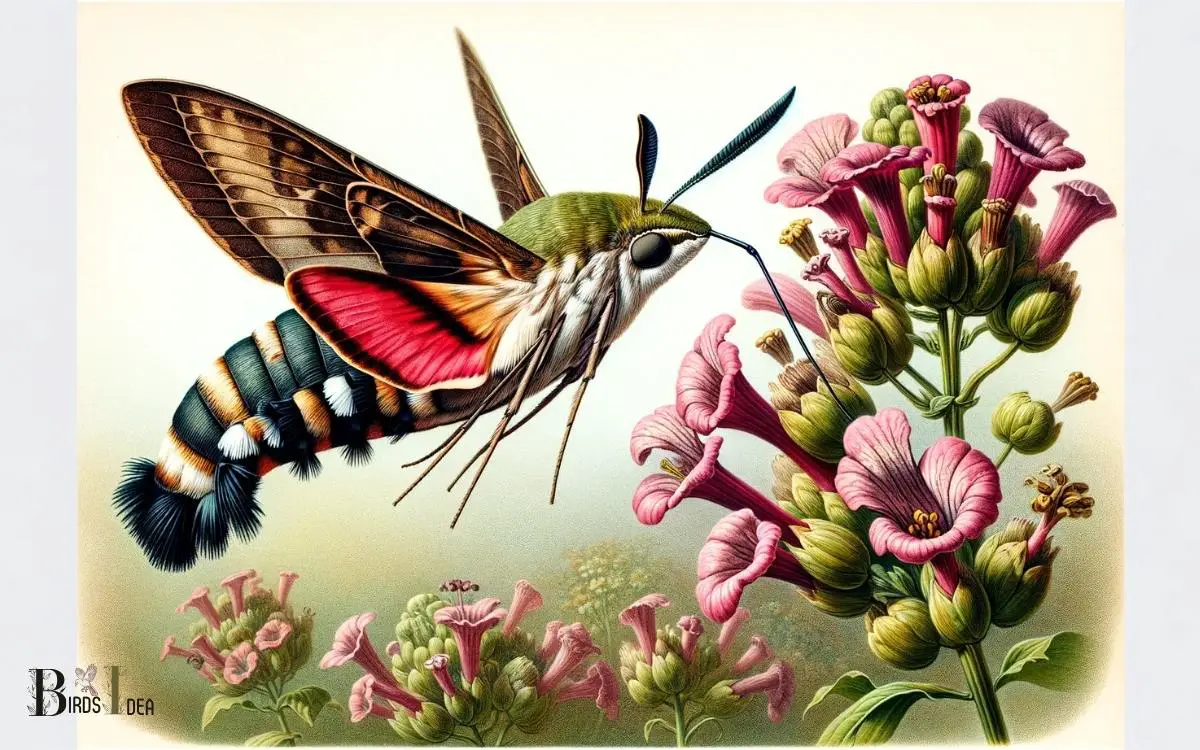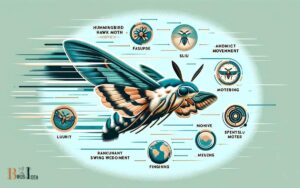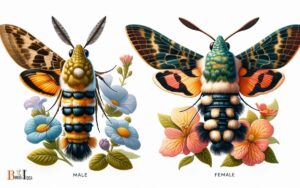Do Hummingbird Hawk Moths Sting: Find Out!
The enigmatic nature of these creatures often sparks curiosity. This article sheds light on the truth behind their alleged stinging capabilities.
Often mistaken for hummingbirds due to their similar feeding behavior, these moths possess intriguing features that are worth exploring.
Understanding their physical characteristics, behavior, and interaction with humans can dispel misconceptions.
Contrary to popular belief, these moths do not sting. By delving into their defense mechanisms and feeding habits, one can appreciate the fascinating world of the Hummingbird Hawk Moth without fear of stings.

Key Takeaway
Identifying the Hummingbird Hawk Moth
The Hummingbird Hawk Moth can be identified by its rapid wing beats and its ability to hover while feeding on nectar from flowers.
This moth, scientifically known as Macroglossum stellatarum, is often mistaken for a hummingbird due to its similar feeding behavior and appearance.
It has a wingspan of approximately 2 inches and is characterized by its olive and maroon coloring, with a distinct black and white striped abdomen.
The moth’s long proboscis, which resembles a hummingbird’s beak, allows it to reach deep into flowers to extract nectar.
Its rapid, agile flight and its preference for bright, fragrant flowers make it a fascinating insect to observe in gardens and meadows.
Understanding these distinguishing features can help enthusiasts and researchers easily identify and appreciate the unique characteristics of the Hummingbird Hawk Moth.
Physical Characteristics and Behavior
The physical characteristics and behavior of the hummingbird hawk moth are of great interest to researchers and enthusiasts alike.
With its long proboscis and rapid wing movements, the moth displays unique flying patterns that captivate observers.
Understanding these physical traits and behaviors is essential to unraveling the mysteries of this fascinating creature.
Sting or No Sting
Hummingbird hawk moths don’t possess a stinger, despite their bee-like appearance and hovering behavior.
This fact is often surprising to people who witness their behavior and assume they’re some form of bee or wasp.
The absence of a stinger is one of the key physical characteristics that distinguishes them from actual stinging insects.
The following are some physical and behavioral traits that further highlight the absence of a stinger in hummingbird hawk moths:
- Their abdomen isn’t equipped with a stinger, unlike bees and wasps.
- They lack the characteristic barbed stinger structure found in stinging insects.
- When threatened, they don’t exhibit defensive stinging behavior.
- Their feeding behavior doesn’t involve stinging, but rather the use of a long proboscis to drink nectar from flowers.
The absence of a stinger in hummingbird hawk moths contrasts sharply with the defensive capabilities of stinging insects.
This leads to the subsequent section about their unique flying patterns.
Unique Flying Patterns
With a rapid and precise flying pattern, hummingbird hawk moths exhibit remarkable agility and maneuverability in their quest for nectar.
These moths have physical characteristics and behaviors that enable their unique flight capabilities.
Their wings beat rapidly, often at a rate of 70 to 80 times per second, allowing them to hover effortlessly in front of flowers while extracting nectar with their long proboscis.
Their ability to fly both forward and backward, similar to hummingbirds, sets them apart from other moth species.
Additionally, their swift and unpredictable flight paths make them challenging for predators to catch. This agility is attributed to their exceptional visual capabilities and strong, streamlined bodies.
Defense Mechanisms: Stinger or Mimicry
The defense mechanisms of the hummingbird hawk moth are a subject of fascination and study among researchers.
One key aspect under investigation is whether the moth employs a stinger or relies on harmless mimicry.
Understanding the evolutionary advantages of mimicry and how it confuses and deters predators is crucial to comprehending the moth’s survival strategies.
Stinger or Harmless Mimicry
The hummingbird hawk moth defends itself through mimicry and not with a stinger. This moth has evolved to mimic the appearance and behavior of hummingbirds, which confuses predators and provides protection.
Instead of relying on a stinger, the moth employs the following defense mechanisms:
- Rapid flight: The moth can swiftly change direction and speed, making it challenging for predators to capture.
- Camouflage: Its coloring and patterns resemble those of a hummingbird, allowing it to blend into its surroundings.
- Hovering: Like hummingbirds, the moth can hover in mid-air, making it difficult for predators to track.
- Startling behavior: When threatened, the moth may suddenly dart away, further confusing predators.
These strategies demonstrate how the hummingbird hawk moth has adapted to defend itself without the use of a stinger.
This mimicry provides significant evolutionary advantages for the hummingbird hawk moth.
Evolutionary Advantages of Mimicry
Evolutionary advantages of mimicry in the hummingbird hawk moth’s defense mechanisms are evident in its successful evasion of predators without the use of a stinger.
This species has evolved to mimic the appearance and behavior of hummingbirds, allowing it to deter potential predators by appearing larger and more threatening than it actually is.
This form of mimicry, known as Batesian mimicry, provides significant advantages in terms of survival.
By resembling a hummingbird, the moth gains protection from its predators, which may avoid attacking it due to the association of the hummingbird’s rapid movements with potential danger or unpalatability.
This evolutionary adaptation has enabled the hummingbird hawk moth to thrive in various environments without the need for a stinger, showcasing the remarkable effectiveness of mimicry as a defense mechanism.
Predators’ Confusion and Avoidance
Confusing and avoiding predators, hummingbird hawk moths utilize mimicry as a defense mechanism instead of relying on a stinger.
This mimicry involves their appearance and behavior, which confuses and deters potential threats.
Here’s how they achieve this:
- Appearance: Hummingbird hawk moths have coloration and patterns that resemble hummingbirds, making it difficult for predators to distinguish between the two.
- Behavior: They hover and dart around flowers while feeding, similar to the movements of hummingbirds, further adding to the confusion for predators.
- Flight pattern: Their rapid, agile flight patterns mimic those of hummingbirds, making it challenging for predators to track and capture them.
- Sound: Hummingbird hawk moths even produce a low humming sound while in flight, reinforcing the illusion of being a hummingbird.
Understanding these defense mechanisms leads to a deeper appreciation of the moth’s feeding habits.
Understanding the Moth’s Feeding Habits
With its remarkable ability to hover and feed on nectar, the hummingbird hawk moth exhibits a fascinating feeding behavior that distinguishes it from other moth species.
Unlike typical moths, which are nocturnal and feed on flowers during the night, the hummingbird hawk moth is diurnal, meaning it’s active during the day.
This moth hovers in front of flowers, using its long proboscis to reach deep into the blooms to extract nectar, much like a hummingbird.
The moth’s rapid wing beats allow it to remain suspended in front of the flower while feeding, and its specialized mouthparts enable it to access nectar from long tubular flowers.
This unique feeding behavior not only sets the hummingbird hawk moth apart from its nocturnal counterparts but also contributes to its vital role as a pollinator in various ecosystems.
Can Hummingbird Hawk Moths Sting Like Hummingbird Moths Bite?
No, Hummingbird Hawk Moths cannot sting like Hummingbird Moths bite. Despite their similar appearance and feeding habits, they don’t possess a stinging mechanism. Their feeding behavior is characterized by their long proboscis, which they use to extract nectar from flowers while hovering, similar to their namesake, the hummingbird moth biting behavior.
Myth Busting: Debunking Sting Misconceptions
Where exactly do hummingbird hawk moths derive their defensive capabilities from?
Many people believe that hummingbird hawk moths sting due to their resemblance to bees and wasps.
However, this is a common misconception. Unlike bees and wasps, hummingbird hawk moths don’t possess a stinger or any venomous capabilities.
Their defensive mechanisms rely on their ability to mimic the appearance and behavior of hummingbirds, which deters potential predators. The moth’s rapid wing movements and swift darting motions further contribute to this illusion.
When approached or threatened, they may also emit a clicking sound using their wings to startle predators.
It’s important to debunk the myth of their stinging capabilities and instead appreciate the fascinating adaptations that hummingbird hawk moths have evolved to ensure their survival in the wild.
Conclusion
The hummingbird hawk moth doesn’t sting. Its defense mechanism relies on mimicry and its ability to hover and move quickly, resembling a hummingbird.
The adage ‘don’t judge a book by its cover’ applies to this moth, as its appearance may lead to misconceptions about its stinging capabilities.
Understanding the behavior and characteristics of the hummingbird hawk moth can help dispel myths and foster a better appreciation for this fascinating insect.






